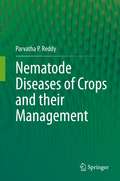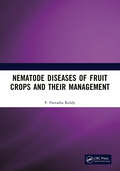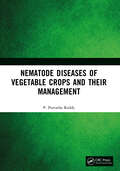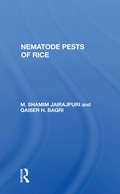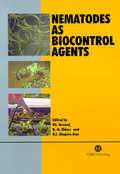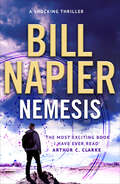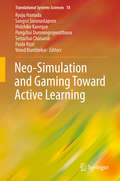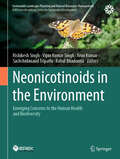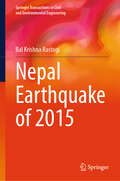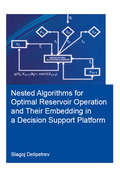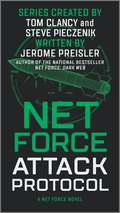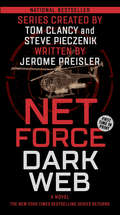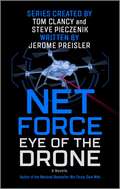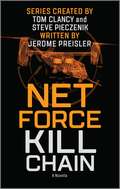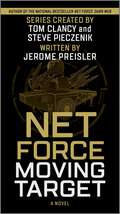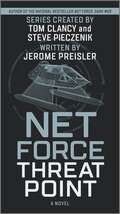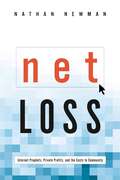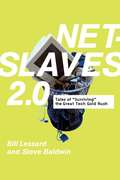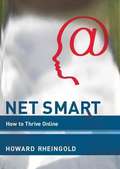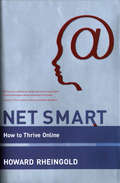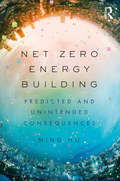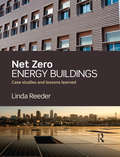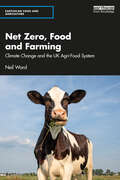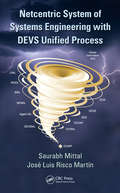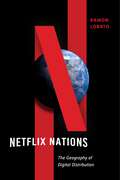- Table View
- List View
Nematode Diseases of Crops and their Management
by Parvatha P. ReddyThis edited book provides knowledge about hemicelluloses biorefinery approaching production life cycle, circular economy, and valorization by obtaining value-added bioproducts and bioenergy. A special focus is dedicated to chemical and biochemical compounds produced from the hemicelluloses derivatives platform. Hemicelluloses are polysaccharides located into plant cell wall, with diverse chemical structures and properties. It is the second most spread organic polymer on nature and found in vast lignocellulosic materials from agro and industrial wastes, therefore, hemicelluloses are considered as abundant and renewable raw material/feedstock. Biorefinery concept contributes to hemicelluloses production associated with biomass industrial processes. Hemicelluloses are alternative sources of sugars for renewable fuels and as platform for chemicals production. This book reviews chemical processes for sugar production and degradation, obtaining of intermediate and final products, and challenges for pentose fermentation. Aspects of hemicelluloses chain chemical and enzymatic modifications are presented with focus on physicochemical properties improvement for bioplastic and biomaterial approaches. Hemicelluloses are presented as sources for advanced materials in biomedical and pharmaceutical uses, and as hydrogel for chemical and medicine deliveries. An interdisciplinary approach is needed to cover all the processes involving hemicelluloses, its conversion into final and intermediate value-added compounds, and bioenergy production. Covering this context, this book is of interest to teachers, students, researchers, and scientists dedicated to biomass valorization. This book is a knowledge source of basic aspects to advanced processing and application for graduate students, particularly. Besides, the book serves as additional reading material for undergraduate students (from different courses) with a deep interest in biomass and waste conversion, valorization, and chemical products from hemicelluloses.
Nematode Diseases of Fruit Crops and their Management
by P. Parvatha ReddySplit into six sections, this book collates information on the various aspects of nematode diseases of fruit crops and their management. The subject matter in this book discusses: International and Indian fruit crop scenario, food and nutritional security, bridging yield gap, and techniques to enhance productivity. Different aspects of nematode diseases in fruit crops such as economic importance, emerging nematode problems, interaction with other pathogens, and nematode management methods. Nematode diseases of tropical, sub-tropical, temperate, and semi-arid fruit crops and their management. The vision for the future including current nematode management strategies, new paradigms for nematode management, transfer of technology, future approaches, and conclusions. This book is aimed at policy makers, practicing farmers, and scientists involved in teaching, research and extension activities related to fruit crop nematodes and their management.Print edition not for sale in India.
Nematode Diseases of Vegetable Crops and their Management
by P. Parvatha ReddyThis book collates information on the various aspects of nematode diseases in vegetable crops and their management. The subject matter in this book discusses: Vegetable crop area, technological interventions to enhance productivity, post-harvest treatments, and integrated pest management. Different aspects of nematode diseases such as economic importance, emerging nematode problems, and major nematode pests and their interaction with other pathogens such as fungi, bacteria, and viruses). Regulatory, physical, cultural, chemical, biological, host resistance and integrated nematode management methods. Nematode diseases of mushrooms, root and leafy vegetables, and solanaceous, leguminous, cruciferous, cucurbitaceous, malvaceous and malvaceous crops. The vision for the future including integrated nematode management, pillars of INM, modifications and expansions to INM, new building blocks of INM, and conclusions. This book is aimed at policy makers, practicing farmers, and scientists involved in teaching, research and extension activities related to vegetable crop nematodes and their management.Print edition not for sale in India.
Nematode Pests Of Rice
by M. Shamim JairajpuriThe triple alliance of pests, pathogens and weeds takes a heavy toll on the yield of rice. Nematodes in particular can cause considerable damage and also present great difficulties in their eradication. Because of difficulties in identification, many nematode pests of rice had gone unnoticed in the past. It is in this context that the present book
Nematodes as Biocontrol Agents
by Parwinder S. Grewal Ralf-Udo Ehlers David I. Shapiro-IlanThis book aims to document and illustrate the major developments in the use of nematodes for biological control of insects and slugs. It has three major sections covering entomopathogenic nematodes, entomophilic nematodes, and slug-parasitic nematodes. Each of these sections discusses biology, commercial production, formulation and quality control, application technology, strategy and safety.
Nemesis
by Bill NapierFive days to save the world.A shocking CIA report confirms Russia has deflected an asteroid on to a collision course with the United States. An elite team of the world’s top astronomers have five days to identify the asteroid – codename Nemesis – and stop it.If they fail, the President will retaliate with a massive nuclear strike.But with time running out, British asteroid expert Oliver Webb discovers that its course was once predicted in an obscure seventeenth-century manuscript, the only copy of which has gone mysteriously missing…Nemesis is an ingenious and utterly gripping thriller, perfect for fans of Dan Brown, Scott Mariani and Andy McDermott. Praise for Nemesis'The most exciting book I have ever read' Arthur C. Clarke‘Outrageously exciting' Literary Review‘Excellent’ New Scientist
Neo-Simulation and Gaming Toward Active Learning (Translational Systems Sciences #18)
by Hidehiko Kanegae Paola Rizzi Ryoju Hamada Songsri Soranastaporn Pongchai Dumrongrojwatthana Settachai Chaisanit Vinod DumblekarThis book provides tips to teachers for moving toward active learning by using simulation and gaming. The book is a rare reference for teachers who wish to initiate active learning by applying many real experiences from world experts in simulation and gaming. This cumulative wisdom comes from cutting-edge trials reported at the 49th International Simulation and Gaming Association’s annual conference in Thailand 9–13 July 2018. The importance of changing teachers’ one-way lecture approach to that of active learning has been commonly understood for several decades and has been promoted especially in recent years in Asian universities. Simulation and gaming meets the requirements of such teaching programs, especially for active learning, but there are few books or references on how to gamify a lecture. This book serves as a guide to facilitate that change. The author recognizes the duty to provide readers with fixed directions toward simulation and gaming in the next generation, which have still not been fully elucidated. Developing a simulation and gaming culture and making it sustainable in the next decade are the purpose of this book.
Neonicotinoids in the Environment: Emerging Concerns to the Human Health and Biodiversity (Sustainable Landscape Planning and Natural Resources Management)
by Arun Kumar Rishikesh Singh Rahul Bhadouria Vipin Kumar Singh Sachchidanand TripathiThe proposed book presents the current state of knowledge about the processes, parameters, and phenomena that influence the fate of neonicotinoids in soil-water systems (i.e., soil and groundwater), as well as their effects and mitigation measures, and identifies existing knowledge gaps. Furthermore, groundwater/surface water interactions, as well as sorption, biodegradation, and chemical transformations of neonicotinoids in the soil and leaching to the groundwater, are highlighted, as they determine their further migration from sources, through soils to groundwater systems, and then to other environmental compartments, posing ecological and human risks. The ecological risks of neonicotinoids are highlighted in a separate section with special emphasis on the impacts on biological diversity.
Nepal Earthquake of 2015 (Springer Transactions in Civil and Environmental Engineering)
by Bal Krishna RastogiThis book describes the source parameters, faulting mechanism, slip distribution, rupture pattern, and aftershock behaviour of the Nepal Earthquake of 2015. This book sheds light on the damage pattern and the geodetic deformation and past seismicity and geology of the region. It also discusses empirical relations useful for assessing future earthquakes and the possible extent of damages caused by the different intensities, magnitude, and duration of aftershocks. Arguments discussed in the book are applicable not only to the Himalayan region but also for similar geological settings worldwide, helping improve disaster management and mitigation planning. This book is of interest to students, researchers, administrators, and planners engaged in earthquake risk reduction.
Nested algorithms for optimal reservoir operation and their embedding in a decision support platform (IHE Delft PhD Thesis Series)
by Blagoj DelipetrevReservoir operation is a multi-objective optimization problem, and is traditionally solved with dynamic programming (DP) and stochastic dynamic programming (SDP) algorithms. The thesis presents novel algorithms for optimal reservoir operation, named nested DP (nDP), nested SDP (nSDP), nested reinforcement learning (nRL) and their multi-objective (MO) variants, correspondingly MOnDP, MOnSDP and MOnRL. The idea is to include a nested optimization algorithm into each state transition, which reduces the initial problem dimension and alleviates the curse of dimensionality. These algorithms can solve multi-objective optimization problems, without significantly increasing the algorithm complexity or the computational expenses. It can additionally handle dense and irregular variable discretization. All algorithms are coded in Java and were tested on the case study of the Knezevo reservoir in the Republic of Macedonia. Nested optimization algorithms are embedded in a cloud application platform for water resources modeling and optimization. The platform is available 24/7, accessible from everywhere, scalable, distributed, interoperable, and it creates a real-time multiuser collaboration platform.This thesis contributes with new and more powerful algorithms for an optimal reservoir operation and cloud application platform. All source codes are available for public use and can be used by researchers and practitioners to further advance the mentioned areas.
Net Force: Attack Protocol
by Jerome PreislerThe cutting-edge Net Force thriller series, created by Tom Clancy and Steve Pieczenik and written by Jerome Preisler, reveals the invisible battlefield where the war for global dominance is fought.The president’s new cybersecurity team, Net Force, is up and running. But a political deadlock in Washington makes the young agency dangerously vulnerable to the criminals, terror groups and hostile governments who would use the digital space to advance their destructive goals.In Central Europe, an unknown enemy mounts a crippling high-tech assault against the organization’s military threat-response unit on its home base. The strike casts suspicion on a core member of Net Force, threatening to destroy the cyber defense group from within. But as they race to track down their attackers, the stakes are suddenly ratcheted higher. For a global syndicate of black hat hackers and a newly belligerent Russia are hatching a mysterious, shadowy scheme for world domination from a place known only as the Secret City.Their attack protocol: leave Net Force in ashes while Moscow and its Dark Web allies set the stage for a devastating strike against the United States.Unless the men and women of Net Force can regroup in time to stop them.
Net Force: Dark Web
by Jerome PreislerThe return of the cutting-edge thriller series Net Force, created by Tom Clancy and Steve Pieczenik and written by Jerome Preisler.The number one threat to our nation’s security is in cyberspace. The new US president wants to tackle the urgent problem head-on and launches a top secret line of defense: Net Force. But before the organization can be announced, the country is hit by an unprecedented, two-pronged terror attack.Not yet empowered by Congress nor embraced by a dubious intelligence community, still untested, unproven and officially unnamed, Net Force’s elite group of cyber experts and field operatives must lead the fight against the ongoing waves of hacks while tracking down the mastermind. Their failure could mean global catastrophe. Success may lead them to become the highest-level security agency in the United States.A story that seems ripped from tomorrow’s headlines, Net Force: Dark Web relaunches one of the most prescient thriller series at a time when cybersecurity is more vital than ever.
Net Force: Eye of the Drone
by Jerome PreislerAn all-new novella in the New York Times bestselling Net Force series, created by Tom Clancy and Steve Pieczenik and written by Jerome Preisler.In Munich, a renowned computer scientist dies. Then, his daughter vanishes. Both under mysterious circumstances.Kali Alcazar, a master hacker, wants to know why. As she delves deeper into the suspicious events, she spots something in the sky — a rare, advanced drone -- and realizes she’s a target herself. A group of mercenary assassins has been assembled with just one goal: to stop Kali from exposing a dark, world-changing secret. Stop her at any cost.They’re not the only ones who are hunting Kali. CIA manhunter Mike Carmody and his elite special ops team are hot on her trail. Their task—bring her to Washington as an internationally wanted cyber-criminal. But that simple mission suddenly becomes a lot more dangerous than they bargained for.In this thrilling novella, the lines blur between hunter and hunted in a battle for tech dominance whose explosive outcome ultimately may be decide the future of international security.
Net Force: Kill Chain
by Jerome PreislerA remote Maine island becomes the setting for a deadly game of cat-and-mouse in the Net Force novella KILL CHAIN.Natasha Mori and Bryan Ferrago work for the Net Force Cyber Squad, an elite government agency created to lead the charge against America&’s online enemies. They&’ve traveled to Maine&’s coast for a project to study extreme weather forecasting—and hopefully enjoy a little vacation.But someone from Natasha&’s past has followed them and, as a hurricane approaches, sees a chance to take her out of commission permanently. A team of elite biotech-enhanced mercenaries has been assigned to eliminate her and any witnesses on the island.Stranded in the storm of the century, cut off from all help, Natasha and Bryan must now find a way to escape her hunters—or become part of their murderous kill chain.
Net Force: Moving Target (Net Force Series #4)
by Jerome PreislerA NEW BATTLE IS BREWING—ONE THAT WILL SOON RAGE ACROSS ALL POLITICAL AND GEOGRAPHIC LINES.As this new threat escalates, the US president calls on the members of Net Force to prevent global chaos.In Paris, the leader of a new political movement has gone into hiding, pursued by a relentless group of bioenhanced assassins. Seeking to rescue him in the mysterious catacombs beneath the city is one of Net Force&’s own, Kali Alcazar, who has become a hunted fugitive herself.Halfway across Europe, meanwhile, her friends are about to strike at the heavily armed fortress of the world&’s most dangerous hacker…and he's prepared a deadly trap for them.&“Jerome Preisler takes us deep into the dark side of the web.&” —Jim DeFelice on Net Force: Attack Protocol&“A tightly woven, expertly crafted story with a finger on the pulse of the overwhelmingly clear and present danger of cyberterrorism.&” —Marc Cameron on Net Force: Dark Web
Net Force: Threat Point (Net Force Series #3)
by Jerome PreislerTHE UNITED STATES MAY SEEM SAFE FROM WITHIN BUT BEYOND ITS BORDERS, A NEW ENEMY RISES An American ship has vanished. The president has tasked the new cyber-intelligence agency, Net Force, with finding out what happened to the vessel. But their investigation reveals a plan that could trigger a world war. Their only option is to strike first. Through the streets of New York, a secret city in Crimea and the depths of the South China Sea, Net Force must race to discover who is behind the attack…before it's too late. &“Jerome Preisler takes us deep into the dark side of the web.&” —Jim DeFelice on Net Force: Attack Protocol &“A tightly woven, expertly crafted story with a finger on the pulse of the overwhelmingly clear and present danger of cyberterrorism.&” —Marc Cameron on Net Force: Dark Web
Net Loss: Internet Prophets, Private Profits, and the Costs to Community
by Nathan NewmanHow has the Internet been changing our lives, and how did these changes come about? Nathan Newman seeks the answers to these questions by studying the emergence of the Internet economy in Silicon Valley and the transformation of power relations it has brought about in our new information age. Net Loss is his effort to understand why technological innovation and growth have been accompanied by increasing economic inequality and a sense of political powerlessness among large sectors of the population. Newman first tells the story of the federal government’s crucial role in the early development of the Internet, with the promotion of open computer standards and collaborative business practices that became the driving force of the Silicon Valley model. He then examines the complex dynamic of the process whereby regional economies have been changing as business alliances built around industries like the Internet replace the broader public investments that fueled regional growth in the past. A radical restructuring of once regionally focused industries like banking, electric utilities, and telephone companies is under way, with changes in federal regulation helping to undermine regional planning and the power of local community actors. The rise of global Internet commerce itself contributes to weakening the tax base of local governments, even as these governments increasingly use networked technology to market themselves and their citizens to global business, usually at the expense of all but their most elite residents. More optimistically, Newman sees an emerging countertrend of global use of the Internet by grassroots organizations, such as those in the antiglobalization movements, that may help to transcend this local powerlessness.
Net Slaves 2.0: Tales of Surviving the Great Tech Gold Rush
by Steve Baldwin Bill LessardTechnology professionals, former employees of failed Internet start-ups, downsized corporate workers, and entrepreneurs eager to avoid mistakes of the recent past will be captivated by this humorous and poignant account of the human cost of the dot.com rise and fall. In the sequel to their acclaimed and successful NetSlaves: Tales of Working the Web, the authors profile the people affected by the rise and fall of Internet companies and where they are today. The coverage in this collection of post-dot.com experiences includes the "survivalists", who made it through the storm intact and continue to work in the industry; the "neo-luddites", who have shunned the Internet forever; the "vigilantes", who are screaming for justice for their mistreatment; and many others. By revealing the most absurd moments of "the bubble" and what really happened to the people displaced by the death of the New Economy, this volume is essential reading for anyone who wants to know what these events mean for the future of the Internet industry.
Net Smart: How to Thrive Online
by Howard RheingoldLike it or not, knowing how to make use of online tools without being overloaded with too much information is an essential ingredient to personal success in the twenty-first century. But how can we use digital media so that they make us empowered participants rather than passive receivers, grounded, well-rounded people rather than multitasking basket cases? In Net Smart, cyberculture expert Howard Rheingold shows us how to use social media intelligently, humanely, and, above all, mindfully. Mindful use of digital media means thinking about what we are doing, cultivating an ongoing inner inquiry into how we want to spend our time. Rheingold outlines five fundamental digital literacies, online skills that will help us do this: attention, participation, collaboration, critical consumption of information (or "crap detection"), and network smarts. He explains how attention works, and how we can use our attention to focus on the tiny relevant portion of the incoming tsunami of information. He describes the quality of participation that empowers the best of the bloggers, netizens, tweeters, and other online community participants; he examines how successful online collaborative enterprises contribute new knowledge to the world in new ways; and he teaches us a lesson on networks and network building. Rheingold points out that there is a bigger social issue at work in digital literacy, one that goes beyond personal empowerment. If we combine our individual efforts wisely, it could produce a more thoughtful society: countless small acts like publishing a Web page or sharing a link could add up to a public good that enriches everybody.
Net Smart: How to Thrive Online (The\mit Press Ser.)
by Howard RheingoldA media guru shows us how to use social media intelligently, humanely, and, above all, mindfully.Like it or not, knowing how to make use of online tools without being overloaded with too much information is an essential ingredient to personal success in the twenty-first century. But how can we use digital media so that they make us empowered participants rather than passive receivers, grounded, well-rounded people rather than multitasking basket cases? In Net Smart, cyberculture expert Howard Rheingold shows us how to use social media intelligently, humanely, and, above all, mindfully. Mindful use of digital media means thinking about what we are doing, cultivating an ongoing inner inquiry into how we want to spend our time. Rheingold outlines five fundamental digital literacies, online skills that will help us do this: attention, participation, collaboration, critical consumption of information (or "crap detection"), and network smarts. He explains how attention works, and how we can use our attention to focus on the tiny relevant portion of the incoming tsunami of information. He describes the quality of participation that empowers the best of the bloggers, netizens, tweeters, and other online community participants; he examines how successful online collaborative enterprises contribute new knowledge to the world in new ways; and he teaches us a lesson on networks and network building. Rheingold points out that there is a bigger social issue at work in digital literacy, one that goes beyond personal empowerment. If we combine our individual efforts wisely, it could produce a more thoughtful society: countless small acts like publishing a Web page or sharing a link could add up to a public good that enriches everybody.
Net Zero Energy Building: Predicted and Unintended Consequences
by Ming HuWhat do we mean by net zero energy? Zero operating energy? Zero energy costs? Zero emissions? There is no one answer: approaches to net zero building vary widely across the globe and are influenced by different environmental and cultural contexts. Net Zero Energy Building: Predicted and Unintended Consequences presents a comprehensive overview of variations in 'net zero' building practices. Drawing on examples from countries such as the United States, United Kingdom, Germany, Japan, Hong Kong, and China, Ming Hu examines diverse approaches to net zero and reveals their intended and unintended consequences. Existing approaches often focus on operating energy: how to make buildings more efficient by reducing the energy consumed by climate control, lighting, and appliances. Hu goes beyond this by analyzing overall energy consumption and environmental impact across the entire life cycle of a building—ranging from the manufacture of building materials to transportation, renovation, and demolition. Is net zero building still achievable once we look at these factors? With clear implications for future practice, this is key reading for professionals in building design, architecture, and construction, as well as students on sustainable and green architecture courses.
Net Zero Energy Buildings: Case Studies and Lessons Learned
by Linda ReederThis book presents 18 in-depth case studies of net zero energy buildings—low-energy building that generate as much energy as they consume over the course of a year—for a range of project types, sizes, and U.S. climate zones. Each case study describes the owner’s goals, the design and construction process, design strategies, measurement and verification activities and results, and project costs. With a year or more of post-occupancy performance data and other project information, as well as lessons learned by project owners and developers, architects, engineers, energy modelers, constructors, and operators, each case study answers the questions: What were the challenges to achieving net zero energy performance, and how were these challenges overcome? How would stakeholders address these issues on future projects? Are the occupants satisfied with the building? Do they find it comfortable? Is it easy to operate? How can other projects benefit from the lessons learned on each project? What would the owners, designers, and constructors do differently knowing what they know now? A final chapter aggregates processes to engage in and pitfalls to avoid when approaching the challenges peculiar to designing, constructing, and owning a net zero energy building. By providing a wealth of comparable information, this book which will flatten the learning curve for designing, constructing, and owning this emerging building type and improve the effectiveness of architectural design and construction.
Net Zero, Food and Farming: Climate Change and the UK Agri-Food System (Earthscan Food and Agriculture)
by Neil WardThis book examines the implications of the net zero transition for food and farming in the UK and how these can be managed to avoid catastrophic climate change in the crucial decades ahead. For the UK to meet its international obligations for reducing greenhouse gas emissions, nothing short of a revolution is required in our use of land, our farming practices and our diet. Taking a historical approach, the book examines the evolution of agriculture and the food system in the UK over the last century and discusses the implications of tackling climate change for food, farming and land use, setting the UK situation in an international context. The chapters analyse the key challenges for this transition, including dietary change and food waste, afforestation and energy crops, and low-emission farming practices. This historical perspective helps develop an understanding of how our food, farming and land use system has evolved to be the way that it is, and draws lessons for how the agri-food system could evolve further to support the transition to net zero and avoid catastrophic climate change. Written in a clear and accessible style, this book will be essential reading to students and scholars of food, agriculture and the environment, as well as policymakers and professionals involved climate change policy and the agriculture and food industry.
Netcentric System of Systems Engineering with DEVS Unified Process (System Of Systems Engineering Ser.)
by Saurabh Mittal José L. Risco MartínIn areas such as military, security, aerospace, and disaster management, the need for performance optimization and interoperability among heterogeneous systems is increasingly important. Model-driven engineering, a paradigm in which the model becomes the actual software, offers a promising approach toward systems of systems (SoS) engineering. However, model-driven engineering has largely been unachieved in complex dynamical systems and netcentric SoS, partly because modeling and simulation (M&S) frameworks are stove-piped and not designed for SoS composability. Addressing this gap, Netcentric System of Systems Engineering with DEVS Unified Process presents a methodology for realizing the model-driven engineering vision and netcentric SoS using DEVS Unified Process (DUNIP). The authors draw on their experience with Discrete Event Systems Specification (DEVS) formalism, System Entity Structure (SES) theory, and applying model-driven engineering in the context of a netcentric SoS. They describe formal model-driven engineering methods for netcentric M&S using standards-based approaches to develop and test complex dynamic models with DUNIP. The book is organized into five sections: Section I introduces undergraduate students and novices to the world of DEVS. It covers systems and SoS M&S as well as DEVS formalism, software, modeling language, and DUNIP. It also assesses DUNIP with the requirements of the Department of Defense’s (DoD) Open Unified Technical Framework (OpenUTF) for netcentric Test and Evaluation (T&E). Section II delves into M&S-based systems engineering for graduate students, advanced practitioners, and industry professionals. It provides methodologies to apply M&S principles to SoS design and reviews the development of executable architectures based on a framework such as the Department of Defense Architecture Framework (DoDAF). It also describes an approach for building netcentric knowledge-based contingency-driven systems. Section III guides graduate students, advanced DEVS users, and industry professionals who are interested in building DEVS virtual machines and netcentric SoS. It discusses modeling standardization, the deployment of models and simulators in a netcentric environment, event-driven architectures, and more. Section IV explores real-world case studies that realize many of the concepts defined in the previous chapters. Section V outlines the next steps and looks at how the modeling of netcentric complex adaptive systems can be attempted using DEVS concepts. It touches on the boundaries of DEVS formalism and the future work needed to utilize advanced concepts like weak and strong emergence, self-organization, scale-free systems, run-time modularity, and event interoperability. This groundbreaking work details how DUNIP offers a well-structured, platform-independent methodology for the modeling and simulation of netcentric system of systems.
Netflix Nations: The Geography of Digital Distribution (Critical Cultural Communication #28)
by Ramon LobatoHow streaming services and internet distribution have transformed global television culture.Television, once a broadcast medium, now also travels through our telephone lines, fiber optic cables, and wireless networks. It is delivered to viewers via apps, screens large and small, and media players of all kinds. In this unfamiliar environment, new global giants of television distribution are emerging—including Netflix, the world’s largest subscription video-on-demand service.Combining media industry analysis with cultural theory, Ramon Lobato explores the political and policy tensions at the heart of the digital distribution revolution, tracing their longer history through our evolving understanding of media globalization. Netflix Nations considers the ways that subscription video-on-demand services, but most of all Netflix, have irrevocably changed the circulation of media content. It tells the story of how a global video portal interacts with national audiences, markets, and institutions, and what this means for how we understand global media in the internet age.Netflix Nations addresses a fundamental tension in the digital media landscape – the clash between the internet’s capacity for global distribution and the territorial nature of media trade, taste, and regulation. The book also explores the failures and frictions of video-on-demand as experienced by audiences. The actual experience of using video platforms is full of subtle reminders of market boundaries and exclusions: platforms are geo-blocked for out-of-region users (“this video is not available in your region”); catalogs shrink and expand from country to country; prices appear in different currencies; and subtitles and captions are not available in local languages. These conditions offer rich insight for understanding the actual geographies of digital media distribution. Contrary to popular belief, the story of Netflix is not just an American one. From Argentina to Australia, Netflix’s ascension from a Silicon Valley start-up to an international television service has transformed media consumption on a global scale. Netflix Nations will help readers make sense of a complex, ever-shifting streaming media environment.
